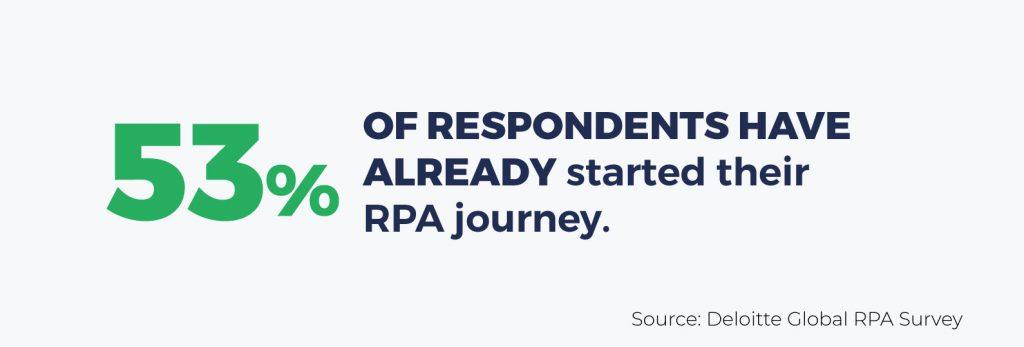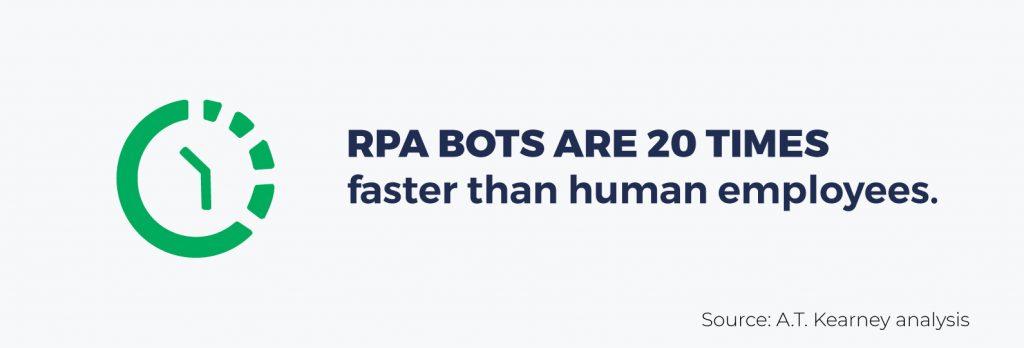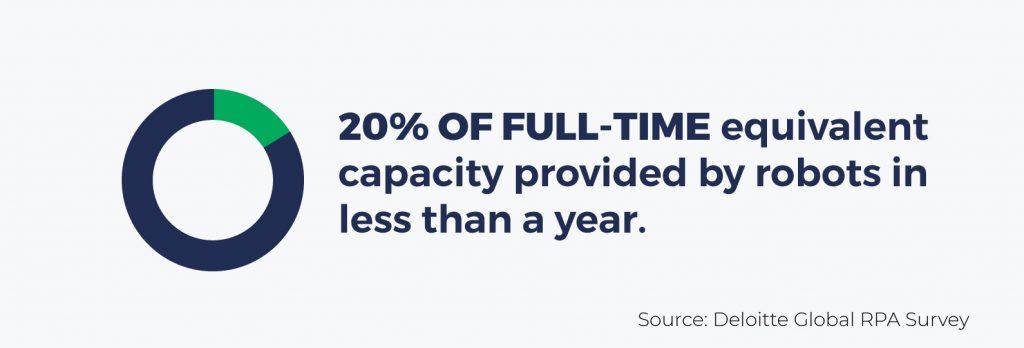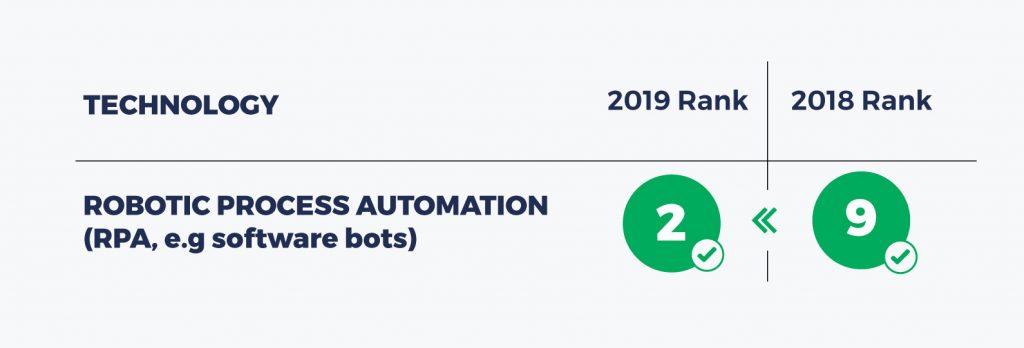In the previous parts, we’ve defined robotic process automation and RPA bots. In this article, we’ll discuss the benefits of RPA implementation, and how to evaluate if a process is a good candidate for automation.
6 Benefits of robotic process automation
Today, the number of software operations executed daily far outpaces humans’ ability to stay focused, absorb, and interpret data. Many businesses have already realized that, and aim to optimize their workflows, which turned robotic process automation (RPA) into a buzzword. With RPA, companies can redirect their employees' creativity into the areas where it’ll do the most good while automating tedious tasks.
Is this the only reason why we need RPA? Is there anything else that software robots can bring to the table? The right answer is yes, there are at least six more advantages of automation.
The low entry threshold
RPA bots mimic how human employees execute tasks, so there’s no need to make major changes in existing IT systems and processes. Also, RPA platforms are usually low-code and don’t require any special IT skills.
Building a bot takes place in the visual drag-and-drop environment that somewhat resembles the mind mapping tools. This doesn’t mean that you won’t require some training, though. There is a learning curve, but if you have some technical background, such as the basic knowledge of JavaScript, it’ll be shortened.

Improved speed
The benefits of robotic process automation are the most noticeable when applied to the formal processes which can be well mapped out — in other words, high-volume, simple, and repeated tasks.
As RPA bots are highly efficient in performing a given sequence of steps, a task that takes a human employee a whole workday to complete can be done by the bot in five minutes. This analysis by Kearney showed that the bots process operations 20 times faster than an average employee (not to mention that RPA bots can work 24/7).

Improved accuracy
Having a human in the loop to complete repetitive mechanical jobs is always a risk. Tasks such as filling out forms or manually transferring data are not only mind-numbing, but they’re also error-prone.
If employees have to go back and forth from copying data from an Excel spreadsheet and filling it into another, sometimes they might paste something twice or start editing the wrong spreadsheet. Even if the initial data was clean, errors might appear after such manipulations. One of the biggest benefits of RPA is that it eliminates any data inconsistencies and reduces the number of errors.

Better compliance
Since RPA activities are well mapped out, they offer transparency, and all the operations can be easily logged and reviewed. Any time access to changelog provides you with better opportunities to monitor and oversight the processes. If there are any issues, you’ll easily conduct root-cause analyses and find out what’s the matter.
Plus, it goes without saying that you can use the benefits of robotic processes when it comes to audit conduction.

Cost savings
Saving a couple of hours for a task might seem not such a big deal at first glance. However, if scaled among hundreds of employees, the business impact and overall RPA efficiency significantly increase. In 2018, Deloitte conducted a global survey where they found out that, within a year, RPA bots provided 20% of full-time equivalent (FTE) capacity on average.

Accelerated digital transformation
Digital transformation is using modern technologies to cut expenses, streamline processes, and grow revenue. Already a priority for many companies, it has become crucial after the pandemic in 2020, which was confirmed by the KMPG report. They named RPA the second most important technology for digital transformation.
At the same time, there’s a common obstacle that many companies have stumbled upon — legacy systems that may be costly to replace and are difficult (or impossible at all) to integrate. Another benefit of RPA is that it can become a bridge between the systems. By mimicking users’ interaction with the systems, it allows you to proceed without developing complex integrations for transferring and processing all the data.

What makes a good RPA opportunity
In terms of RPA efficiency, a simple but high-volume and repetitive process has priority. However, there are usually multiple processes in companies as well as many stakeholders from different departments who can ask you to automate their tasks. In any case, it’d be good to be able to score the candidates and start with the ones that will get the max results of the RPA benefits. Here are the main factors to consider:
Checklist: Processes that are a good fit for RPA
- Tedious routines, such as copy-and-pasting.
- Repetitive processes where the sequence of steps is always the same.
- Rule-based activities that are already formalized or can be easily mapped out.
- The process involves using structured data.
- Time-consuming tasks.
- Error-prone processes (when handling structured information).
In addition to the list above, we can also add that robotic process automation can be a helping hand even in one-time situations when employees need to perform a large amount of mechanical work. For example, this can be generating thousands of documents for an audit request. Such work may take a human employee all workday (or multiple workdays), while a developer can spend an hour on developing a bot, and the bot will complete the task in a few minutes.
When you shortlist the processes that are a good fit for RPA, you’ll need to compare one versus another. Here are the four basic principles when choosing what to start from:
1. The more person-hours you save, the better
However, employees should spend this freed time doing other tasks. If the employees assign a bot with the task and then have to idly wait for its completion, the result and RPA ROI will be less attractive.
2. The less time it takes to develop an RPA bot, the faster you’ll see the payoff
This doesn’t mean that you should only automate simple copy-and-paste activities, though. It’s just better to switch to more complex and time-consuming processes automation when you’ve created the bots for the tasks with a more tangible effect.
3. The fewer systems involved in the process, the easier it is to automate it
A rule of thumb would be to start with the processes that handle the data from two or three systems rather than seven or more. Every additional system involved adds potential breakpoints and requires extra attention.
4. If the process has a comprehensive API, it’s much easier to automate
If the process doesn’t have an API, you still can automate it, but you’ll need to use visual scripting automation: make the robot imitate human actions in the GUI (click buttons, fill in fields, etc.). The use of an RPA solution, such as Studio Pro by ElectroNeek, might be a good choice in this case because there’s a low entry threshold, and it’s convenient to maintain such bots.
On the other hand, RPA can't do anything that can't be done by a script, say, in Python. However, you’ll need at least a mid-level engineer, a bunch of tests, libraries, and so on to implement the same automation in code. At the end of the day, it’ll likely be more expensive and take more time.
What processes might be not a good fit for RPA
Although there’s nothing impossible, it’s better to keep in mind these three factors that can make efficient RPA automation more difficult, namely:
- The process involves handling unstructured data, for example, handwritten papers.
- The process is frequently changed. For example, a new regulation comes up weekly, and you need to comply with it.
- The high-cognitive tasks that require employees to make decisions based on their intuitive interpretation of the situation and apply creative thinking.
However, there’s a solution in such cases, too: you can try combining automation with human decision-making. This is often is referred to as attended automation. For example, you can assign a bot to sort out documents, and if the bot finds an item that it cannot identify, it forwards this file to manual review.
The examples of business process automation
RPA is finding increasing applications across plenty of domains, so let’s have a look at some of the industry-specific areas for RPA application:
- Accounting: reconciliations, preparing data for audits, and invoicing
- Banking: operations with accounts, loan processing, and reporting
- Healthcare: appointments management and maintenance of patients’ records
- Insurance: claim processing and calculating plans
- IT: backups and data migration
- Logistics: delivery scheduling and asset management
- Real estate: rental transaction management
- Retail: order and billing management
- Sales: creating sales quotations and follow-ups
Key takeaways
- There are six main benefits of robotic process automation: a low entry threshold, accelerating rule-based tasks execution, improved data accuracy, more efficient use of employees’ talents, and better compliance. Plus, RPA can become a foundation for digital transformation.
- The first candidates for robotic process automation are simple but high-volume and repetitive tasks.
- The high-cognitive tasks, the frequently changed processes, and tasks that deal with unstructured data might not be the best fit for RPA.
What’s next?
In the next article, we’ll dive deeper into the nuts and bolts of how RPA works and what you need to successfully integrate it with your systems.
Stay tuned to learn everything about RPA, and if you prefer to ask your questions personally, ElectroNeek’s RPA experts are more than happy to conduct a call tailored to your business needs.
